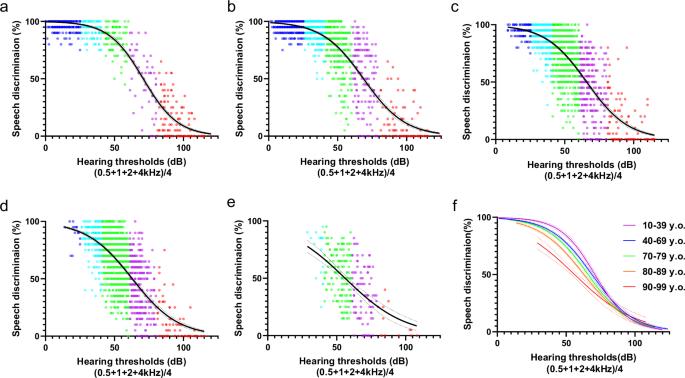The effect of aging and asymmetrical hearing on speech discrimination
IF 5.4
Q1 MEDICINE, RESEARCH & EXPERIMENTAL
引用次数: 0
Abstract
Speech discrimination (SpD) is exacerbated by hearing loss, but the relationship between pure-tone audiometry (PTA) and SpD is poorly described and understood in the aging process. It is also unclear whether severity of left-right (L-R) differences in PTA threshold disproportionately affects SpD. We conducted a retrospective cross-sectional study of a broad age range (10–99 years) of patients in Japan. Demographic data, SpD, and PTA threshold data were collected for each patient and side (L-R). We evaluated the association between chronological age and overall SpD, and SpD according to severity of PTA-threshold difference for ear pairs. Asymmetries in L-R PTA thresholds were stratified into four equally spaced categories: <10dB L-R difference to ≥40 dB L-R difference. Among the 2760 eligible participants, data from 5508 ears are analyzed. Overall SpD gradually decreases with age, with SpD scores in the oldest groups being significantly worse (Kruskal-Wallis followed by Dunn’s test; p < 0.0001) than those of the youngest group. Comparison of worse-hearing ears to better-hearing ears within the same severity of hearing impairment reveals significant differences on SpD in ears that have moderate or severe hearing impairment (p < 0.0001). Post-hoc analysis identifies significant differences in SpD between the worse-hearing ears and the better-hearing ears that have hearing differences of 20 dB or more. SpD is dramatically affected by age and asymmetrical hearing. Therefore, appropriate audiological interventions should be proactively considered according to an individual’s hearing level, age, and difference in L-R hearing levels. The ability to understand speech is impacted by hearing loss. Pure-tone hearing tests are commonly used to test hearing. The relationship between pure-tone hearing tests and speech perception tests during aging is poorly understood. It is also unclear whether severity of differences in hearing between the ears affect speech perception. We evaluated the association between chronological age and speech perception score, as well as speech perception score according to severity of hearing difference between ears, in a large dataset from Japan. We found speech perception is dramatically affected by age and the presence of asymmetrical hearing. Our results suggest that appropriate audiological interventions should be proactively considered according to an individual’s hearing level, age, and whether they have asymmetrical hearing. Wasano et al. evaluate the impact of age and asymmetrical hearing on pure-tone hearing thresholds and speech discrimination in a large number of participants aged between 10 and 99 years. Age and asymmetrical hearing are shown to affect the relationship between pure-tone hearing thresholds and speech discrimination.

老化和听力不对称对语言辨别能力的影响
背景:听力损失会加剧言语辨别力(SpD),但在老龄化过程中,纯音测听(PTA)与言语辨别力之间的关系却鲜有描述和了解。此外,纯音测听阈值左右(L-R)差异的严重程度是否会对 SpD 产生不成比例的影响也尚不清楚:方法:我们对日本不同年龄段(10-99 岁)的患者进行了一项回顾性横断面研究。我们收集了每位患者和每侧(L-R)的人口统计学数据、SpD 和 PTA 阈值数据。我们评估了实际年龄与总体 SpD 之间的关系,以及根据耳双 PTA-阈值差异的严重程度得出的 SpD。将 L-R PTA 阈值的不对称分为四个等距的类别:结果:在 2760 名符合条件的参与者中,对来自 5508 耳的数据进行了分析。总体 SpD 随年龄的增长而逐渐降低,年龄最大组的 SpD 分数明显较差(Kruskal-Wallis,然后进行邓恩检验;P 结论:SpD 受年龄的影响很大:SpD受年龄和听力不对称的影响很大。因此,应根据个人的听力水平、年龄和 L-R 听力水平差异,积极考虑采取适当的听力干预措施。
本文章由计算机程序翻译,如有差异,请以英文原文为准。
求助全文
约1分钟内获得全文
求助全文

 求助内容:
求助内容: 应助结果提醒方式:
应助结果提醒方式:


